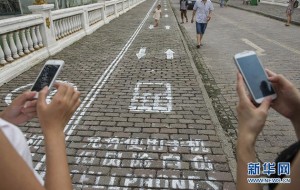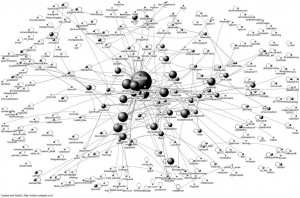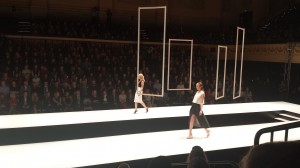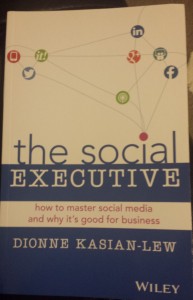Venturing back pre 2006, Chris Anderson revels in the new wave of media consumerism that has risen out of the ease of access and choice that the development of the internet has enabled. Declaring that ‘with online distribution and retail, we are entering a world of abundance’, we are now presented with profound differences to our traditional methods of media consumption. From the mid 2000’s onwards, the internet began its permeation into our everyday lives and with it, slowly erased the restrictions that went hand in hand with DVD shops, book stores and even analogue broadcast television. Online however, with sites such as Netflix as Apple’s iTunes, not only has the access to media transformed but so as the economics of it. Now, with an abundance of films, music and books available at the touch of a button, it no longer matters what kinds of books are more likely to sell in one region of a state than in another, or more problematically, how many people want to watch your favourite horror film on a rainy saturday night. The internet ‘has, in short, broken the tyranny of physical space. What matters is not where customers are, or even how many of them are seeking a particular title, but only that some number of them exist, anywhere. Also, now with the extensiveness of options, alternate links, related alternative viewings and ability to bookmark pages as ‘favourites’, access to everything that still existed before the internet is now accessible in a networked and interlinked medium. Reading throughout this article however it amazes me how the content in which was deemed as so innovative not only 1o years ago now seems so primeval. Even more so because we have been born into the generation that has grown up parallel to the revolutionary developments of the internet, we are able to understand the significance of how much has change in such little time.
Neutrality and Speeds of Technology
Whether I’m beginning to reach saturation point in regards to absorption of theories and ideas on network media, or perhaps this week’s symposium was just a bit less comprehensive than others but this week I found myself, and I hope I’m not alone, struggling to take in all that was discussed my Adrian, Elliot and Jason. Maybe I’ll just put it down to the abstract yet vague nature that governs the concept of ‘neutrality’ of which was discussed for majority of the symposium. What is ‘neutrality’? According to the discussions that have unraveled both in the symposium and in class this week it is the term that describes the notion of an something being uninvolved and unmotivated by other surrounding objects, circumstances, cultures or people. Naturally stemming from this, the question was raised, ‘How can anything live abstractly by itself?’ Of course, from what we know at this moment, nothing can. Perhaps it could have 200 years ago when everything we know now was still undiscovered, invisible to the world and various cultures but right now, everything must exist in relation to something else. This concept is certainly something that takes a few goes to wrap your heads around, but as abstract as it may seem, it does make a lot of sense. How can a pen exist as a stand alone, individual object? It exists because people need to communicate and because it needs a smooth surface, ink, and a literate person to operate it.
Nearing the end of the class in a quick wrap up Adrian threw a final thought provoking concept at the group regarding the idea of speeds of technology. Referring to Jason’s laptop, Adrian pointed out that although he was holding a piece of state of the art technology, he was also holding something that included technology that dated back 150 years. I laughed at this, realising how right he was and how silly I felt that despite spending so much of my time on my laptop, not once had this thought crossed my mind. Even though Jason’s laptop was the newest edition mac book air, most likely equipped with retina display and the highest speed processor, it still possessed a keyboard that mimics almost exactly that of the keyboards from typewriters. Additionally, it also contained a camera built into the screen, despite the fact that cameras have been around for over 100 years. Looking at technology like this really does reflect the old saying ‘some things never go out of fashion’, and that even though the speed of technological development is faster than its ever been before, we are still very much dependent on the technology that has been around longer than any living person.
Losing Sight…
There’s nothing more annoying then dropping your shopping, or even worse your coffee, because you’ve been blinded bumped into by someone too immersed in their mobile phone. A small town in China however have decided to tak a stand on this annoying consequence of modern day life! I really hope this is merely an act of boredom and comedy from the local council in Chongqing city and won’t be something that becomes a necessity on our own sidewalks!
To checkout the article click here
Connect The Dots
This week’s reading by Barabasi took a new approach to the concept of network media by comparing the way in which we network ourselves online and way in which we network in person. Speaking of the most common way a social network exists, whereby we each circulate within one or two close ‘cluster’ of friends yet we ourselves, nor are the other members of that cluster socially exclusive to that one group alone. Therefore, the members of these two close ‘clusters’ generally know each other and often coincide with one another at parties and through similar interests. Additionally, you may have many other ‘acquaintances’ outside of these clusters who may have ‘acquaintances’ in your clusters and so on. In comparing this type of network with that of the networks online, I realise now just how dissimilar they are. Online, it is not a question of your opinion or knowledge being published, but more of whether or not it will be read. The more incoming links to your page, the deeper and wider your work seeps into the online system, holding a higher chance of being noticed. This I now see is very much the same in society. The more acquaintances you have, the more connections you have to those small clusters, therefor the more widespread you are through social groups and greater chance you have of someone in seemingly dispute social group knowing who you are.
For much of this subject we have discussed what is network media, how it has come about and why. Now 8 weeks into the semester its almost funny to see how much of our ingrained social behaviour is so unnoticeably imbedded in our technology. Putting aside the social media sites such as Facebook, Twitter, Instagram etc, of which were obviously developed with the singular role of social communication, it’s amazing to see how the fundamental operating system of the internet and the networking of websites through search engines is so similar to how we socialise in society. As outlined, in society you are simply apart of one big network, your connections with others forming links between clusters that may seem ‘random’ yet through that one link can be associated with you. This as we all know is the exact same as internet whereby that are the most ‘well known’ web pages have only achieved that stauts through their many links to other sites.
The Modern Evolution of Language
Collage, Lines of Narrative Progression and Plot
Collage…the piecing together of different matter, perhaps of different forms in such a manner that they become linked and related in some way. Within the reading that interested me the most this week, Shields discusses the concept of collage throughout his work whilst in a paralleled thread of discussion also questions the role and necessity of ‘plot’. In a bold and somewhat audacious manner, shields declares ‘plots are for dead people’, arguing that it is now the art of collage that is the dominating literature of today. What interested me so much about this reading was the way in which I both heavily disagreed and agreed with the ideas being presented.
Firstly, i disagree that plots are no longer needed and I believe that that are also something that are unavoidable. As plots are the series of events within a story that make up some sort of pattern, they are something that arise out of any form of writing, even within the form of collage. In relating this concept to the structure of the internet as shields does himself, I agree that the network like system of the internet is undeniably like that of a collage as ‘The very nature of collage demands fragmented materials, or at least materials yanked out of context’ of which occurs when using the internet through hypertext. However, I believe that when using the internet you could argue that the presence of a plot is both recognisable and valid. You start off on google, search the organisation the ‘The Cancer Council’, you then search their web page, then continue onto their Facebook page, their twitter page, youtube channel, wikipedia page then end your journey by downloading their app. Is this not a series of events that are related through a pattern?
However, I also then do agree with Shields’s further questioning of his initial overconfidence in the form of collage as he poses the questions, ‘How long do you not need a story?’ and with the constant weaving ways of the web ‘how long will the reader stay engaged?’ Perhaps we need both plot based narratives and collage influenced literature. Do we really need to move away and almost eradicate everything that is traditional just to give ourselves confirmation of advancement? Maybe we’re all just shooting ourselves in the foot here…
Life Outside of Uni – MSFW!
Ah the mid semester break. Even though it was only one week, I worked full days for almost half of it and there was plenty of group assignments to be done, to my utter joy and luck, semester break this year fell perfectly on Melbourne Spring Fashion Week. Here are a few snaps of Fashion Show 2 for those that are needing an ease back into the regular course based posts.
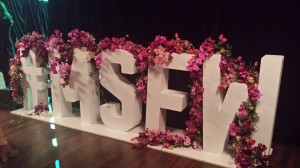
The Social Executive – Dionne Kasian Lew
A couple of weeks ago I had this book suggested to me by a friend of mine. Published this year, this modern and futuristically focused novel is all about the importance and vitality of network media in the establishment and sustainability of businesses today. Throughout this novel we are ironically presented with the modern concepts we are discussing in both our classes and symposiums that revolve around understanding various media platforms and utilising an online presence as a key to connect with others within your industry through the traditional and now seemingly constrictive form of a written book. However, although I doubt many of us have arrived at the point of owning a business, ‘The Social Executive’ is definitely worth a flip through if anyone is wishing to ferment their understanding of the type of work place we will all soon be finding ourselves in.
Cultural and Literary Issues Arising out of Networked Media
Following on from my previous post, during this weeks symposium the bulk of discussion was focused around the following two ideas; ‘can technology progress independently of art and culture?’ and ‘is the internet causing a permanent change in our literary format ?’. Initially when the first question was raised I instinctively disagreed. How can you remove culture from technology when technology is now embedded within it? We use technology everyday, our entire existence now balances on our deep reliance on technology from medical tools and equipment to kitchen and cooking appliances. However, when Betty raised the issue of a ‘tool’ vs ‘technology I begin to wonder what defines each of these terms? What is art. What is technology? Is technology simply an object that is new? Perhaps it may be old to one culture but new in another? Technology isn’t simply an object with an electrical source. It can a pen, fire, the wheel etc. So then if technology is dependent on how and when it is introduced, does that make art a product of new thinking that enables the development of technology? If we were to follow on with that idea then really art and culture cannot develop independently of technology because we need the art to create the technology that becomes woven into the foundations of our culture.
Following on nicely from talk about movements into the future, we then began to discuss the non linear format of internet and how it has influenced literature of today. Within ‘traditional media’ i.e written books, there is a physical and real distance between sources that does not exist within ‘modern media’ i.e the internet. As per the example that was given by Adrian, if you were reading about nutrition and then wanted to go deeper into your reading and read up on the digestive system, the physical format of book require you to get up off your chair and walk up the stairs to the biology section on level two of the library yet with the internet, all the information is able to arrive at the same time, equally distant from one another. The structure of the internet is non-linear, it is literally a network of sites that that equally distant from each other, causing no distinctive shape, no edge, no ending or centre. When we read a book out of order, we know and accept just that, that it is ‘out of order’. Yet this does not occur in the format of the internet.
Will this forever change the way we write? Will there no longer be a need for words such as ‘therefor’. Writing for the web now forces us to write in a manner than enables viewing at any angle.
What defines technology?
A quick but necessary post during today’s symposium. The tutors hold different opinions on what is ‘technology’? In the midst of this discussion whilst searching a news website I quite coincidentally came across an article on nail polish posted under the catgeory ‘Technology’. I found this both amassing and confusing.
